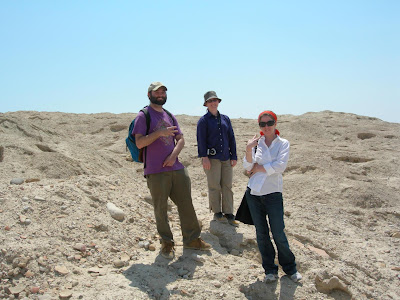
Pretty cool huh?

Oddly, some enterprising local or archaeologist thought that these stones could be combined to make sculpture by putting a worn out mortar on top of a grinder. We thought they were right.
 After completing our work at Numeira, we retired to a shady tree for a magnificent feast of sardines, hummus, olives, and oranges. We then visited the site of Bab edh-Dhra (meaning "Gate of the Arm" in Arabic) about 15 kms north of Numeira, also an Early Bronze site and very well known to archaeologists for the extensive cemetery (one of the few known from the period anywhere in the southern Levant). There was also a walled town site near the cemetery; much of the town site has disappeared as severe erosion takes away the north side. Bab edh-Dhra was first occupied during the Early Bronze I, or first major phase of the Early Bronze Age, but continued to grow, with a wall built around the town estimated at about 10 acres.
After completing our work at Numeira, we retired to a shady tree for a magnificent feast of sardines, hummus, olives, and oranges. We then visited the site of Bab edh-Dhra (meaning "Gate of the Arm" in Arabic) about 15 kms north of Numeira, also an Early Bronze site and very well known to archaeologists for the extensive cemetery (one of the few known from the period anywhere in the southern Levant). There was also a walled town site near the cemetery; much of the town site has disappeared as severe erosion takes away the north side. Bab edh-Dhra was first occupied during the Early Bronze I, or first major phase of the Early Bronze Age, but continued to grow, with a wall built around the town estimated at about 10 acres. In the cemetery, shaft tombs were dug into the soft chalky marls, and the remains of between 2-10 people were deposited in the chamber, including men, women, and some children (infants were rare). Mortuary goods were also included, including hand made pottery, bowls made of basalt, maceheads and other iterms. Unfortunately the site has been looted for years, destroying the majority of tombs and leaving scattered broken artifacts and human bones.
Here you can see the "Craters of Bab edh-Dhra", where a vast cemetery has been turned into a wasteland. Looters will make very little money for the items they find but the middlemen who buy them will enjoy a hefty mark-up. Unfortunately the destruction to the archaeological remains is devastating.

We had a very good, productive day and after the disheartening site of Bab edh-Dhra, we went off to visit the PPN site of 'Dhra, just up the road. The site has been excavated so there is very little to see now, but the flowers were in bloom, the goats were happy, and the blade cores bountiful, so all in all, a fine finish to the field day. We then headed off for the new Panorama overlook site, where the breeze keeps the ghor flies at bay and the capucho is pretty good. We also had to go looking for a gas station after climbing the hill to the Panorama overlook.
 Thanks everyone for all the hard work!
Thanks everyone for all the hard work!


No comments:
Post a Comment